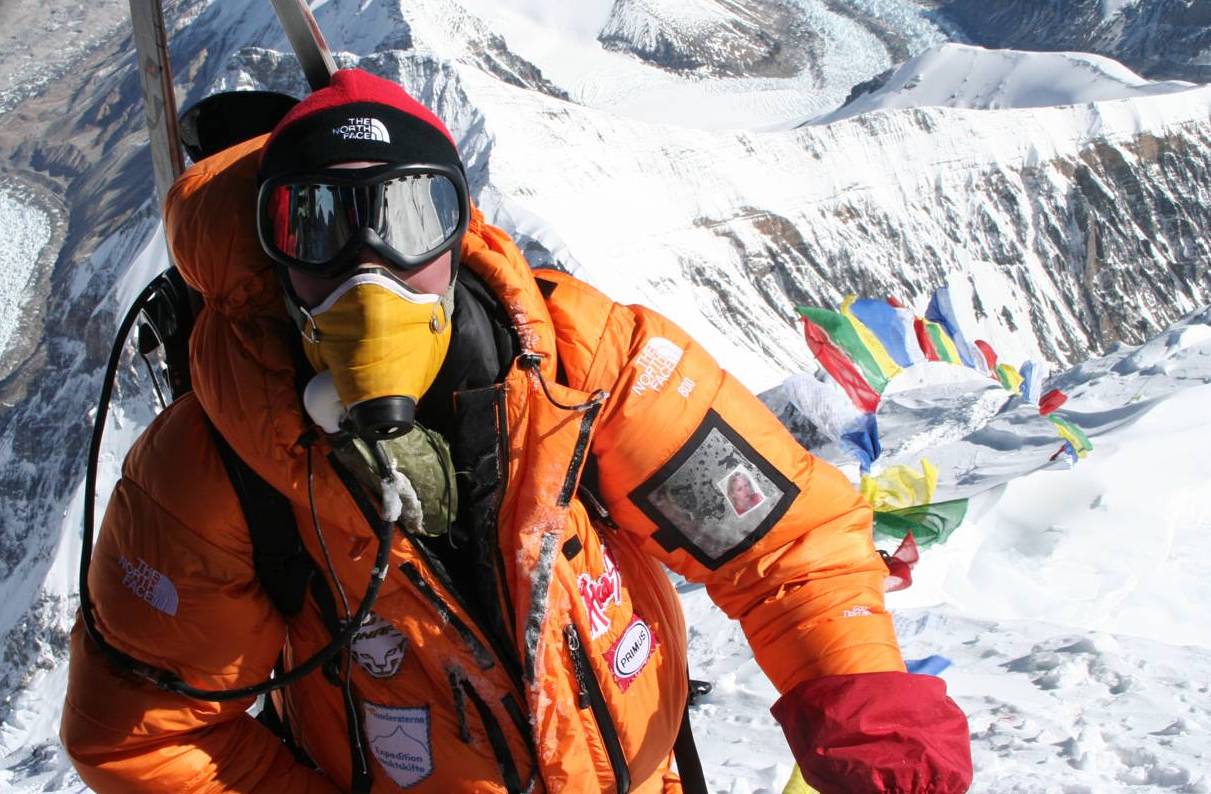High-altitude mountaineering is a miserable endeavor. In the rarefied air of the world’s highest peaks, there’s simply not enough oxygen for the body to function normally.
At great height, however, our genes kickstart a whole host of corporeal changes. Notably, our bone marrow starts churning out new red blood cells and the heart rate quickens. Nonessential bodily functions like growing nails and hair slow down to conserve energy for more important matters like food digestion.
Nevertheless, above an altitude of about 17,000 feet, it’s hard to ever truly acclimate. (At some 16,732 feet above sea level, the mining town of La Rinconada in the Peruvian Andes is the highest permanent settlement in the world.) And once you ascend past about 26,000 feet — the threshold of the so-called “death zone” — you begin to die.
Besides the labored breathing, high altitude causes come climbers to become nauseated to the point of vomiting. Some may develop pounding headaches, nosebleeds, and coughing fits severe enough to crack ribs. Climbers’ windpipes can become clogged by mucus plugs that require a Heimlich maneuver to dislodge.
Despite the astronomical energy demands of mountaineering, the appetite fades to nothing. To make up for the energy deficit, your body metabolizes its fat reserves and cannibalizes muscle tissue.

To make matters worse, it’s practically impossible to digest fatty foods in the oxygen-deprived atmosphere. For that reason, high-altitude mountaineers stick to easily digestible carbohydrates. Pop tarts and energy bars are some particularly popular mountaineering hacks.
The catch, however, is that fat contains more than twice the number of calories per gram than carbohydrates. Arctic and Antarctic adventurers, for example, routinely rely on extremely high-fat diets since they offer more bang per gram than carbohydrates. High-altitude mountaineers, on the other hand, simply cannot digest nature’s most efficient source of energy — fat. Thus unable to keep their internal furnaces fired up full bore, mountaineers are significantly more prone to hypothermia and frostbite than their polar-adventuring brethren.
The deoxygenated air at high altitude also confuses the body’s detection of internal carbon dioxide levels — the mechanism upon which our lungs normally rely to autonomically regulate the pace of breathing while at sea level. Consequently, many climbers also develop sleep apnea — a disconcerting condition in which they stop breathing during their sleep and wake up to a gasping start.
Taking it slowly — or pole, pole, as the Swahili-speaking guides on Mount Kilimanjaro say — is a universally accepted piece of advice to avoid succumbing to altitude sickness or its more potent cousins: high-altitude pulmonary edema (HAPE) and high-altitude cerebral edema (HACE).

HACE causes the brain to accumulate extra fluid, swell, and stop functioning properly. The condition can be so severe that a climber’s eyes appear to bulge out from their sockets. A related illness, HAPE causes fluid to enter the lungs. If left untreated, both of these afflictions are potentially fatal.
Once above 10,000 feet, most mountain medicine guidelines advise against gaining more than about 1,000 feet per day. This conservative rate of ascent allows the body to keep pace with its acclimatization processes. In any case, the altitude at which you sleep is most important when it comes to preventing altitude sickness. On rest days, therefore, it’s best to do some moderate exercise and ascend briefly to a higher elevation before coming back down for sleep. These short forays trigger the body’s responses to adapt to less oxygen, while allowing for more complete recovery during the night.
Ultimately, one’s susceptibility to altitude sickness has more to do with genetics than fitness. Being in shape certainly helps, but it’s no guarantee you won’t get sick. Thus, in order to stack the odds in their favor, high-altitude climbers have resorted to some unusual mountaineering hacks to fend off the potentially lethal effects of high altitude.
Here are a few.
Garlic
According to mountaineering lore, eating garlic can help prevent altitude sickness. At practically any Sherpa village in the Himalayas that caters to passing trekkers or climbers, you’re sure to find garlic soup on the menu — and the proprietors are likely to offer you garlic cloves to chew on, to boot.
As far as this correspondent is concerned, if something works for Sherpas, it’s good enough for me. And, in fact, there’s some legit science to back up garlic’s utility in fending off altitude sickness.
Like aspirin, garlic thins the blood. It also increases circulation and might improve the body’s ability to use oxygen, according to some studies. Consuming garlic can also allay the symptoms of nausea and lightheadedness that are commonly associated with the onset of altitude sickness. Plus, yetis are known to hate the smell of it.

Viagra
The savior of many a middle-aged marriage may also help you get up the mountain.
Originally developed to treat high blood pressure, Viagra promotes erections by opening up blood vessels and increasing blood flow — especially where it matters most.
The lungs, of course.
A 2003 German study found that taking the drug sildenafil — commonly known as Viagra — increased maximum exercise capacity at both sea level and at high altitude. When it comes to high-altitude sports performance, the study found that Viagra reduced high pressure in the lungs’ blood vessels, allowing for more oxygen to be absorbed. That reduced pressure also helps carry away fluid building up in the lungs, which is the cause of HAPE.
“The benefit in terms of climbing is if someone is suffering altitude sickness […] that particular drug will help you dilate those blood vessels and carry that fluid away from the lungs, because if you don’t get that fluid out you can actually drown in (them),” Australian mountaineer Andrew Lock, who has climbed all 14 of the world’s 8,000-meter peaks, told CNN in 2016.
After it was published in the August 2004 issue of the Annals of Internal Medicine, climbers quickly caught wind of the German Viagra study. A separate 2006 study published by the American Physiological Society found that Viagra significantly improved the cardiovascular and exercise performance of trained cyclists at high altitude — up to 45% in some cases. However, some of the test subjects saw no performance improvement, suggesting that the little blue pill may not work for everyone who climbs into thin air.
Nevertheless, in the Thamel neighborhood of the Nepali capital of Kathmandu — a popular waystation for mountaineers and trekkers en route to the Himalayas — most pharmacies are now bountifully stocked with Viagra.
Diamox
Commonly known by the brand name Diamox, acetazolamide is a medication widely used to both treat and prevent the symptoms of mountain sickness.
Basically, Diamox changes the acidity of your blood to reduce internal fluid buildup and increase your autonomic rate of breathing. It’s so effective that many doctors advise taking Diamox in advance of abrupt changes in altitude to avoid sickness.
The downside is that Diamox causes you to urinate multiple times in the night — a miserable proposition while hunkered down in a tent on a mountain slope. And the drug can leave your fingers with a disconcerting tingling sensation. Yet, Diamox is a proven remedy for the symptoms of altitude sickness, and it deserves to be in any high-altitude adventurer’s medical kit.
Lay off the booze, bro. (And the coffee, too.)
Dehydration has scuttled many mountaineering dreams. The combination of the cold, dry air and the endless hours of rapid, deep breathing wrings moisture out of your body like twisting a pool towel dry.
Alcohol and caffeine, unfortunately, are diuretics that speed up the dehydration process. Thus, they’re both generally off limits at high altitude. Nevertheless, it’s not uncommon to spot a few beers in the base camps of the world’s highest peaks.
Be an Ironman
Mountaineering legend Conrad Anker — who starred in the documentary film Meru and discovered the body of English climber George Mallory on Mount Everest — is known to chew on pork chops and bacon while at high altitude. But he generally skips the fattiest pieces if he’s at extreme altitude.
“I’ve always seen the iron and protein as a benefit to climbing at altitudes,” Anker said in a 2016 interview with National Geographic.
While crushing carbohydrates is generally the go-to diet while climbing to the limits of the troposphere, the body also desperately needs the building blocks from which it can create new red blood cells — one of the most important physical adaptations for lower oxygen levels.
High in iron, light in weight, generally tasty and easy on the fat, beef jerky is a solid option to get in some iron and protein — thereby helping your body to churn out those red blood cells. And it probably won’t make you barf.
Read Next: How Two Special Operations Veterans Found Each Other — and Healing — in the Himalayas








Comments